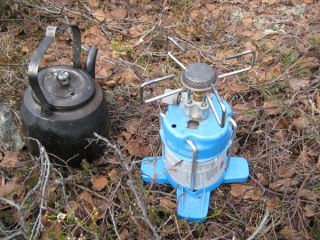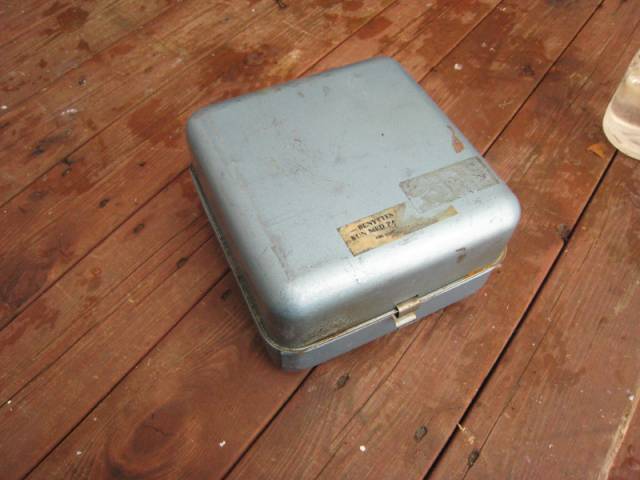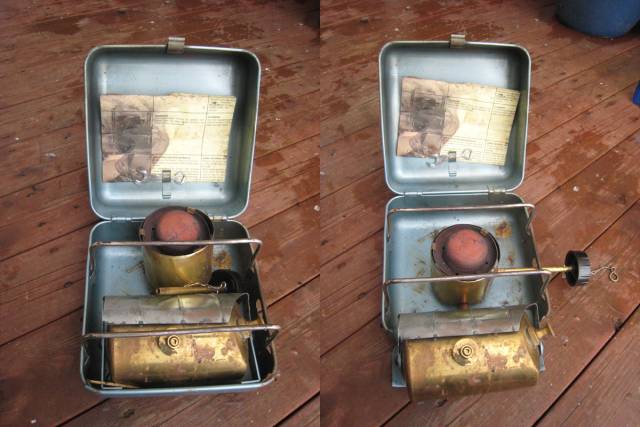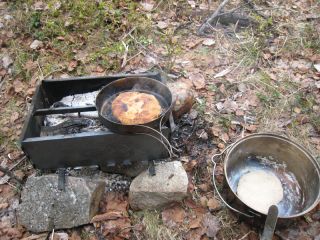|
Stoves
Butane stove

Although I own a butane stove I seldom use it.
I sometimes bring it along when out driving longer stretches just to brew some coffee when having a break.
Or I use it when making char cloth at home.

The stove is easy to use and work very well in the summertime. Just turn the valve, light it and you’re cooking.
In winter time I don’t use it. The reason is that the butane liquefies in the cold and makes the stove less efficient.
Update:
The summer 2011 I bought a fairly cheap butane stove which screws on to a treaded canister.
This stove has seen much use already, due to its size and ease in use. The stove comes with a yellow plastic box for protection when not in use.
Optimus 111 Hiker

In winter, when no fire wood is found, I use kerosene fuelled, pressure stoves.
My favourite is the Optimus 111 Hiker. The main reason for this is that I used them in the army and found that they work well both for warming our tents and cooking.
The maximum output of this stove is 3000 Watt. Burning time for 0.35 litres on full throttle is 2 hours.

The stove is mounted in a tough metal casing and has a ready pot stand. The stove has to be preheated. I use alcohol, “Rødsprit”, as I find it better than the pasta that the stove was delivered with.

Yes, it is heavy (1.6 kilos), has many parts that could break and they require regular maintenance, but I have had trouble with mine only once.
The trouble had more with the fuel to do than the stove. The fuel had left wax in the fuel line clogging it up. It was -25° Celsius when this occurred and the stove was really needed. A large needle or a piece of brass wire would have fixed this problem, but we didn’t have any.
I had left the small bag of “repair” items I usually carry at home, because I never had any use for it earlier. Well, lesson learnt.
I had the official repair set to the stove though.
Optimus Nova
Another stove I use is the Optimus Nova. This is also a good stove with.
This stove has a separate burner and fuel tank/pump with the combined weight of about 500 grams.
This stove could use a variety of fuels, but I use only kerosene.
This stove also needs preheating, but you actually don’t need additional fuel for preheating. Just pump it up, release some fuel to saturate the wick under the burner and light it.
This method gives of a little more soot than the alcohol preheating though.
The output of this stove is said to be 2850 Watt.
The fuel flow is easily cut off by turning the fuel bottle.
I’ve had some issues with it though.
When I was in Børgefjell with my father we used this stove. It was the first time it was used (except for the trials at home) and suddenly it stopped. No fuel came trough the burner.
We took it apart and found a small piece of “silicone” in the burner.
We then took apart the fuel line and in one end there was a “silicone” gasket. I ripped it out and have not had this trouble since.
Sometimes, especially in cold weather, the link between the fuel line and burner is a little tricky. The lock will not slid into its place and thus making the seal leak or not working at all.
It helps to keep this connection oiled.
Tent tipi fire box

This is actually my most used “stove”. Having a fire in my lavvu using the fire box contra an open fire is like night and day. No more coughing and running eyes.
The box is made of thin steel plates hinged together and it is very easy to set up.
Less smoke in my lavvu is not the only plus this box has. You use much less fuel and the fuel is burnt very efficient.
The support bar in the middle of the box makes a good pot stand. I have room for both my cooking pots on this stove.

The box is 30cm X 20cm x 11.5cm when set up (mini model) and 4cm X 30cm x 11.5cm in transport mode. The weight of the box is 1.2 kilos.


I bought this stove after long and hard thinking and research. Initially I thought the stove looked flimsy, prone to rust and I thought it was a little expensive.
But a couple of years use made me hooked. This is in my opinion one of the best buys I’ve done.
Be sure to buy a canvas bag to put it in, or make one cheap yourself, or it will make your pack very dirty.
|